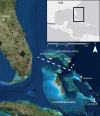Population structure of a widespread bat (Tadarida brasiliensis) in an island system
- PMID: 29043016
- PMCID: PMC5632666
- DOI: 10.1002/ece3.3233
Population structure of a widespread bat (Tadarida brasiliensis) in an island system
Abstract
Dispersal is a driving factor in the creation and maintenance of biodiversity, yet little is known about the effects of habitat variation and geography on dispersal and population connectivity in most mammalian groups. Bats of the family Molossidae are fast-flying mammals thought to have potentially high dispersal ability, and recent studies have indicated gene flow across hundreds of kilometers in continental North American populations of the Brazilian free-tailed bat, Tadarida brasiliensis. We examined the population genetics, phylogeography, and morphology of this species in Florida and across islands of The Bahamas, which are part of an island archipelago in the West Indies. Previous studies indicate that bats in the family Phyllostomidae, which are possibly less mobile than members of the family Molossidae, exhibit population structuring across The Bahamas. We hypothesized that T. brasiliensis would show high population connectivity throughout the islands and that T. brasiliensis would show higher connectivity than two species of phyllostomid bats that have been previously examined in The Bahamas. Contrary to our predictions, T. brasiliensis shows high population structure between two groups of islands in The Bahamas, similar to the structure exhibited by one species of phyllostomid bat. Phylogenetic and morphological analyses suggest that this structure may be the result of ancient divergence between two populations of T. brasiliensis that subsequently came into contact in The Bahamas. Our findings additionally suggest that there may be cryptic species within T. brasiliensis in The Bahamas and the West Indies more broadly.
Keywords: Bahamas; Caribbean; Chiroptera; Molossidae; West Indies; dispersal.
Figures







Similar articles
-
A Fly on the Cave Wall: Parasite Genetics Reveal Fine-scale Dispersal Patterns of Bats.J Parasitol. 2019 Aug;105(4):555-566. J Parasitol. 2019. PMID: 31348717
-
Acarine infracommunities associated with the Mexican free-tailed bat, Tadarida brasiliensis mexicana (Chiroptera: Molossidae) in arid regions of Mexico.J Med Entomol. 2003 Nov;40(6):996-9. doi: 10.1603/0022-2585-40.6.996. J Med Entomol. 2003. PMID: 14765683
-
Identification and characterization of novel alphacoronaviruses in Tadarida brasiliensis (Chiroptera, Molossidae) from Argentina: insights into recombination as a mechanism favoring bat coronavirus cross-species transmission.Microbiol Spectr. 2023 Sep 11;11(5):e0204723. doi: 10.1128/spectrum.02047-23. Online ahead of print. Microbiol Spectr. 2023. PMID: 37695063 Free PMC article.
-
Functional and structural optimization of the respiratory system of the bat Tadarida brasiliensis (Chiroptera, Molossidae): does airway geometry matter?J Exp Biol. 2005 Oct;208(Pt 20):3987-95. doi: 10.1242/jeb.01817. J Exp Biol. 2005. PMID: 16215224
-
The West Indies as a laboratory of biogeography and evolution.Philos Trans R Soc Lond B Biol Sci. 2008 Jul 27;363(1502):2393-413. doi: 10.1098/rstb.2007.2068. Philos Trans R Soc Lond B Biol Sci. 2008. PMID: 17446164 Free PMC article. Review.
Cited by
-
Species delineation and genetic structure of two Chaerephon species (C. pusillus and C. leucogaster) on Madagascar and the Comoro archipelago.Ecol Evol. 2022 Dec 3;12(12):e9566. doi: 10.1002/ece3.9566. eCollection 2022 Dec. Ecol Evol. 2022. PMID: 36479032 Free PMC article.
-
Genetic diversity, structure, and effective population size of an endangered, endemic hoary bat, 'ōpe'ape'a, across the Hawaiian Islands.PeerJ. 2023 Jan 25;11:e14365. doi: 10.7717/peerj.14365. eCollection 2023. PeerJ. 2023. PMID: 36718450 Free PMC article.
-
Risk Modeling of Bat Rabies in the Caribbean Islands.Trop Med Infect Dis. 2020 Mar 1;5(1):35. doi: 10.3390/tropicalmed5010035. Trop Med Infect Dis. 2020. PMID: 32121504 Free PMC article.
-
Rabies in the Caribbean: A Situational Analysis and Historic Review.Trop Med Infect Dis. 2018 Aug 20;3(3):89. doi: 10.3390/tropicalmed3030089. Trop Med Infect Dis. 2018. PMID: 30274485 Free PMC article.
-
The Serological Prevalence of Rabies Virus-Neutralizing Antibodies in the Bat Population on the Caribbean Island of Trinidad.Viruses. 2020 Feb 5;12(2):178. doi: 10.3390/v12020178. Viruses. 2020. PMID: 32033370 Free PMC article.
References
-
- Beerli, P. (2006). Comparison of Bayesian and maximum‐likelihood inference of population genetic parameters. Bioinformatics, 22, 341–345. - PubMed
-
- Berger, J. (2004). The last mile: How to sustain long‐distance migration in mammals. Conservation Biology, 18, 320–331.
-
- Best, T. L. , & Geluso, K. N. (2003). Summer foraging range of Mexican free‐tailed bats (Tadarida brasiliensis mexicana) from Carlsbad Cavern, New Mexico. The Southwestern Naturalist, 48, 590–596.
Associated data
LinkOut - more resources
Full Text Sources
Other Literature Sources

